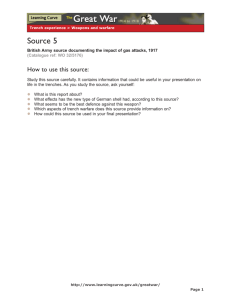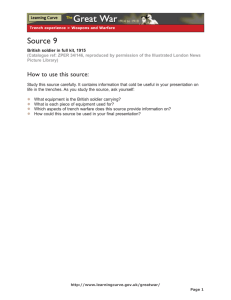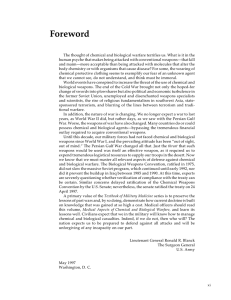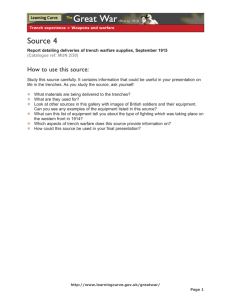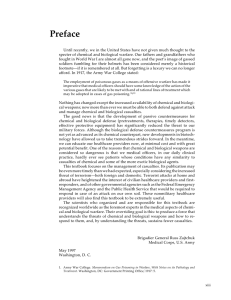PLANNING AREAS SERVICE PLANNING AREAS Foster High-Quality People
advertisement
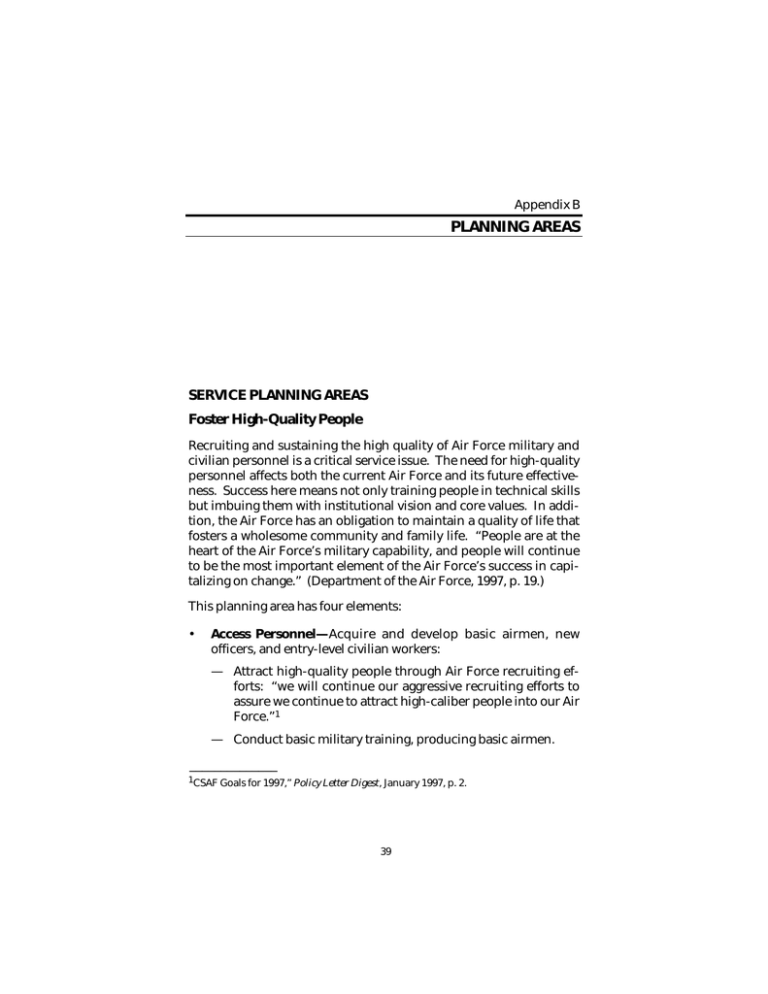
Appendix B PLANNING AREAS SERVICE PLANNING AREAS Foster High-Quality People Recruiting and sustaining the high quality of Air Force military and civilian personnel is a critical service issue. The need for high-quality personnel affects both the current Air Force and its future effectiveness. Success here means not only training people in technical skills but imbuing them with institutional vision and core values. In addition, the Air Force has an obligation to maintain a quality of life that fosters a wholesome community and family life. “People are at the heart of the Air Force’s military capability, and people will continue to be the most important element of the Air Force’s success in capitalizing on change.” (Department of the Air Force, 1997, p. 19.) This planning area has four elements: • Access Personnel—Acquire and develop basic airmen, new officers, and entry-level civilian workers: — Attract high-quality people through Air Force recruiting efforts: “we will continue our aggressive recruiting efforts to assure we continue to attract high-caliber people into our Air Force.”1 — Conduct basic military training, producing basic airmen. ______________ 1 CSAF Goals for 1997,” Policy Letter Digest, January 1997, p. 2. 39 40 Defining a Common Planning Framework for the Air Force — Provide precommissioning programs, such as the Air Force Academy and the Reserve Officer Training Corps, to produce new officers. • Train and Educate Personnel—Provide continuing professional development throughout Air Force careers, reinforcing the Air Force’s “core values in all aspects of its education and training . . . throughout a career.” (p. 21.) Moreover, the “civilian career development program needs to be improved to create the same institutional commitment and responsibility in all our people— military and civilians.”2 • Maintain Quality of Life—Ensure that life in the Air Force will be wholesome and attractive for all its members. The Air Force places and will continue to place a high priority on “providing quality of life for Air Force members and their families.” (p. 19.) It is also committed to preserving “a ‘sense of community’ at its bases maintaining the Quality of Life standards while searching for new and more efficient ways of providing them.”3 • Assure Good Order and Fair Treatment of Personnel—Administer and enforce military justice and provide programs to ensure equal opportunity and absence of harassment. Evolve Through Innovation The Air Force depends on technology and innovation to develop its operational capabilities. It is continually affected by technological change. Thus, innovation underlies all the operational planning areas. To maintain its edge over other nations, the Air Force must constantly develop new operational concepts and systems that effectively exploit emerging technology. “The key to ensuring today’s Air Force core competencies will meet the challenge of tomorrow is Innovation.” (p. 10.) This planning area also has four elements: ______________ 2 Briefing, “CORONA Fall ’96 Long-Range Planning, Summary Themes,” slide 23. 3 Briefing, “CORONA Fall ’96 Long-Range Planning, Summary Themes,” slide 25. Planning Areas 41 • Provide Analytic Capability—Invest in analytic activities, including models and simulations. • Sponsor and Conduct Basic and Applied Research—Invest in research whose military application is promising but still undetermined, including laboratories. These capabilities explore the potential for affecting military operations, rather than simply responding to operational needs. Battle laboratories with operational focus would fall in other planning areas. • Empower New Ideas—Experiment with new ways to make progress in the operational planning areas, including test centers. “The Air Force is committed to a vigorous program of experimenting, testing, exercising and evaluating new operational concepts and systems for air and space power.” (p. 9.) This would include setting up Battle Labs “to provide institutional, operational focus for testing, evaluating, and prototyping new concepts for Air and Space combat in the 21st Century.”4 • Develop Doctrine for Air and Space Power—Work to formulate and promulgate the current understanding of how the Air Force will contribute to accomplishing the operational objectives that unified commanders and civil authorities set. Development of doctrine is an explicit Title 10 responsibility. OPERATIONAL PLANNING AREAS Operational planning areas are related to the requirements of unified commanders, generally on the level of joint operational objectives. These areas reflect the perspective of the Air Force as the service uniquely able to provide global reach and global power. The Air Force also generates air and space power to support civil authorities, for example, in disaster relief and interdiction of illegal drug traffic. ______________ 4 Briefing, “CORONA Fall ’96 Long-Range Planning, Summary Themes,” slide 5. 42 Defining a Common Planning Framework for the Air Force Dominate Air and Space Operations The Air Force has a unique ability to dominate operations in air and space, that is, to operate freely and deny freedom to opponents in the mediums of air and space. Sister services contribute to domination of air operations, but only the Air Force operates through the airspace continuum on a global basis. Success here is the fundamental, indispensable precondition for success in other planning areas. This planning area corresponds to the core competency of Air and Space Superiority: “The control of air and space is a critical enabler for a Joint force because it allows all U.S. forces freedom from attack and freedom to attack. With air and space superiority, the Joint Force can dominate enemy operations in all dimensions—land, sea, air, and space.” (p. 10.) This is also spelled out as “Gain and maintain air superiority in theater of war.” (CJCS, 1996, p. 2-56.) The key elements in dominating air and space operations are as follows: • Suppress Air Defenses—Coordinate, integrate, and synchronize attacks that “neutralize, destroy, or temporarily degrade surfacebased enemy air defenses by destructive and/or disruptive means.” (CJCS, 1996, p. 2-112.) • Defeat Air Forces—If necessary, defeat, rather than merely countering, attacking, or neutralizing opposing air forces. Air base attack and air-to-air engagement are implied in this capability. It involves countering enemy air attacks in a theater of operations by intercepting, engaging, destroying, or neutralizing enemy formations in the air, “using all available air-, land-, or sea-based air defense capabilities of the joint force to achieve operational result,” (CJCS, 1996, p. 2-131), including attacks on aircraft and missiles (CJCS, 1996, p. 2-112). • Suppress and Defend Against Cruise and Ballistic Missiles— Defend against the growing theater and global threat posed by cruise and ballistic missiles, which is “one of the developments accelerating warfare along the air-space continuum.” (Department of the Air Force, 1997, p. 10.) The Air Force currently Planning Areas 43 considers these threats separately, but “over time it will merge them into a common missile defense architecture.”5 • Ensure Access to Space, Protect Friendly Space Assets, and Counter Opposing Space Assets—Provide the capabilities required to dominate operations in the medium of space. This means ensuring “access to space, freedom of operations within the space medium, and an ability to deny others the use of space, if required.” (U.S. Space Command, 1997.)6 Since U.S. Space Command already supports the warfighter through its missions of space control and space force application, “the further militarization of space will be driven by international events, national policy, threats moving through and from space, and threats to US space assets.” (Department of the Air Force, 1997, p. 17.) The Air Force must be prepared to move further at NCA direction. Attack Anywhere on the Globe The Air Force has a unique ability to attack targets located anywhere on the globe quickly and precisely. From its commanding position in air and space, the Air Force can use conventional weapons to engage any target that can be tracked. In concert with land and sea forces, the Air Force capability for global attack can dominate terrestrial operations. If necessary, the Air Force can also employ nuclear weapons with the greatest selectivity possible for such devastating means. This planning area corresponds to the core competencies of Global Attack and Precision Engagement. Global attack refers to the ability to attack rapidly anywhere on the globe As part of that ability, the “Air Force will sustain its efforts in the nuclear area and strengthen its response to the growing risk of proliferation.” (Department of the Air Force, 1997, p. 11.) Precision engagement refers to the Air Force’s “ability to apply selective force against specific targets and achieve ______________ 5 Briefing, “CORONA Fall ’96 Long-Range Planning, Summary Themes,” slide 18. 6 The document also offers alternative formulations: “dominating the space dimen- sion of military operations” and “the emerging synergy of space superiority with land, sea, and air superiority.” 44 Defining a Common Planning Framework for the Air Force discrete and discriminate effects.” (Department of the Air Force, 1997, p. 13). The following are key elements of this planning area: • Project Air Forces Globally—Provide the services needed to generate global power, except air refueling (which is collected in the “provide global mobility” planning area). The following must be considered in this context: — Forward base forces: Costs are incurred in basing air forces permanently in foreign countries. “U.S. forces permanently stationed and rotationally or periodically deployed overseas serve a broad range of U.S. interests.” (Cohen, 1997, p. 6). — Preposition stocks: Stocks are maintained in forward locations to support air operations during crisis and war. — Deploy expeditionary forces: Air and space power contribute to engagement and presence “by augmenting those forces that are permanently based overseas with temporary or rotational deployments and power projection missions.” (Department of the Air Force, 1997, p. 7). “The Air Force will develop new ways of doing mobility, force deployment, protection, and sustainability in support of the expeditionary concept.” (Department of the Air Force, 1997, p. 11). • Dominate Land Operations—Use new sensing technologies and sensor-fuzed weapons to allow air power to deny movement by day and night, fixing maneuver forces in disadvantageous positions. The tasks distinguish between interdiction of maneuver forces and close air support with the implied requirement for precise and flexible forward air control, usually in cooperation with U.S. and allied land forces engaging an enemy. • Dominate Sea Operations—Gain and maintain maritime superiority in a theater of war. This task attacks the enemy’s warfighting capabilities at sea via antisubmarine warfare, antiair warfare, defensive counterair, air interdiction, and traditional surface and subsurface warfare. Antiair warfare and defensive counterair are encompassed in the planning area “dominate air and space.” (CJCS, 1996, p. 2-56.) Maritime operations are a collateral mission for the Air Force under Title 10. Planning Areas 45 • Degrade and Destroy Infrastructure—Reach over the battle area and attack an enemy in full strategic depth, reducing its war making potential. The goal is to destroy or neutralize strategiclevel targets and to shape and control the tempo of theater campaigns and joint operations, “using all available joint and allied firepower assets against land, air (including space), and maritime (surface and subsurface) targets having strategic significance.” (CJCS, 1996, p. 2-62.) • Counter Weapons of Mass Destruction—Improve the nation’s ability to deter and prevent the effective use by an adversary of nuclear, biological, and chemical weapons, to defend against them, and to fight more effectively in an environment in which such weapons are used. (Cohen, p. 5.) In recognizing the dangers posed by the efforts of other nations to acquire nuclear weapons, the “Air Force will sustain its efforts in the nuclear area and strengthen its response to the growing risk of proliferation.”7 (Department of the Air Force, 1997, p. 11.) Weapons of mass destruction upset regional balances, promote intimidation, and force the “have nots” to seek them as well. “Therefore, we must be able to find, track, and neutralize an adversary’s WMD Capability.”8 Provide Global Mobility The Air Force is able to lift rapidly a wide range of passengers and cargo, including outsized military equipment, anywhere in the world. Global mobility is fundamental to America’s status as a world power because there may not be enough warning to permit reliance on slower means of transportation. Even in the absence of suitable basing, the Air Force ensures global reach through the world’s most capable aerial refueling fleet. It provides airlift and aerial refueling not only in benign conditions but also under combat conditions in ______________ 7 Although nuclear weapons may pose the most serious risk, rogue states might also seek to develop biological and chemical weapons, as Iraq did prior to the Gulf War; therefore, we preferred the broader term “weapons of mass destruction.” 8 Special Operations Command, SOF Vision 2020, MacDill Air Force Base, Florida, 1997, p. 6. 46 Defining a Common Planning Framework for the Air Force denied air space. Currently, global mobility means airlift, but in the future it may include spacelift. This planning area corresponds to the core competency of Rapid Global Mobility, providing the nation its global reach and underpinning its role as a global power: “When an operation must be carried out quickly, airlift and aerial refueling will be the key players.” (USAF, 1997, p. 12). A primary source for capabilities and tasks is the Air Mobility Master Plan (AMMP) (AMC, 1997). Global mobility requires the Air Force to • Provide Lift in Controlled Airspace—Transport personnel and cargo through airspace controlled by friendly forces. This includes lifting — Combat and support personnel, including “unit rotations, and movement of the President and senior government or executive personnel” (AMC, 1997, p. 1-12) — Regular passengers, that is, military personnel and civilians without special requirements — Very important persons, that is, military and civilian officials with rank or status requiring special amenities, security, and communications — Medical patients (aeromedical evacuation, providing “rapid worldwide transportation of ill or injured personnel to appropriate medical care” (AMC, 1997, p. 1-10) — Materiel and equipment, delivering “supplies and equipment whose urgency or nature cannot wait for surface transportation” (AMC, 1997, p. 1-10). • Provide Lift in Denied Airspace—Transport personnel and cargo when opposing forces might seek to deny access. This includes — Providing combat delivery (airdrop), unloading personnel or material from aircraft in flight. “This combat employment and resupply of forces is used when the airland option is not available.” (AMC, 1997, p. 1-10.) — Lifting special operations forces, providing specialized airdrop support to special operations forces for joint or com- Planning Areas 47 bined training, contingencies, operations other than war, and other missions. (AMC, 1997, p. 1-13.) — Rescuing personnel and recovering equipment, rescuing downed air crews and sensitive items of equipment from denied areas. (CJCS, 1996, p. 2-134.) • Refuel Aircraft in Flight—Using air tankers for refueling during — Normal operations, to allow “rapid deployment of fighters, bombers, and combat support aircraft” (AMC, 1997, p. 1-11.) — Special operations, to provide air refueling of joint, multinational, or special operations aircraft, as distinguished by the customer’s unique requirements. Air refueling requires special equipment, specialized crew training, and modified operational procedures. Today’s refueling fleet was originally developed to support strategic nuclear bombers. Such missions have additional associated hazards, because they “may be conducted in a nuclear detonation environment, leading to electromagnetic pulse, flash blindness, and routing problems.” (AMC, 1997, p. 1-10.) Achieve Global Awareness and Control of Forces Immense leverage can be gained through information dominance and its exploitation by using timely and effective command and control. 9 The ability to view a battlespace in near real time—observing the movements of both friendly and opposing forces while blinding an enemy or distorting his vision—can give unified commanders crushing advantages. This planning area focuses attention on the revolution in military affairs made possible by microelectronics and computing: “Information technology advances will make dramatic changes in how this nation fights wars in the future.” 10 The Air Force is a natural leader in this planning area because of its leading role in ______________ 9 These objectives are fundamental to military operations by all services at all levels of warfare from initial planning through execution and are therefore integral to other planning areas. But the current pace of technological advance and the great expense of applying these technologies justify creation of a separate planning area. 10Ronald R. Fogleman and Sheila E. Widnall, “Cornerstones of Information Warfare,” Department of the Air Force, 1997. 48 Defining a Common Planning Framework for the Air Force space and its extremely rapid, flexible applications of air and space power. This planning area corresponds to information superiority in the Joint Vision: “Information superiority will require both offensive and defensive information warfare (IW). Offensive information warfare will degrade or exploit an adversary’s collection or use of information.” (Shalikashvili, 1995, p. 10.) “Gain and maintain information superiority in theater of war/area of responsibility” is defined as achieving information superiority by affecting an adversary’s information, information-based processes, and information systems, while defending one’s own information, information-based processes, and information systems. (CJCS, p. 2-56.) According to former Air Force Chief of Staff General Ronald Fogleman and former Air Force Secretary Sheila Widnall, “Information Warfare has become central to the way nations fight wars, and will be critical to Air Force Operations in the 21st century.”11 This planning area also corresponds to the core competency of Information Superiority: While Information Superiority is not the Air Force’s sole domain, it is, and will remain, an Air Force core competency. The strategic perspective and the flexibility gained from operating in the airspace continuum make airmen uniquely suited for information operations. . . . Providing Full Spectrum Dominance requires a truly interactive common battlespace picture. (Department of the Air Force, 1997, p. 14.) This includes Global Awareness and Command and Control: “These competencies are brought together by global awareness and command and control to provide air and space power to the Joint Force Team.” (Department of the Air Force, 1997, p. 9.) Achieving global awareness and control of forces involves ______________ 11Ibid. Planning Areas 49 • Providing worldwide communications and information systems—This is fundamental to all information warfare. • Protecting worldwide communications and information systems—“The top IW priority is to defend our own increasingly information-intensive capabilities.” (Department of the Air Force, 1997, p. 14.) Information assurance is defined as information operations that “protect and defend information and information systems by ensuring their availability, integrity, authentication, confidentiality, and non-repudiation. This includes providing for restoration of information systems by incorporating protection, detection, and reaction capabilities.”12 • Providing worldwide information—In the near term, the highest payoff here is in providing worldwide intelligence, surveillance, and reconnaissance. (Department of the Air Force, 1997, p. 14.) The Air Force must provide “reliable and effective space-based navigation, communications, and weather support.”13 • Providing intelligence, surveillance, and reconnaissance—The focus here is on theater strategic intelligence, surveillance, and reconnaissance. (CJCS, p. 2-57.) • Providing battle management and command and control—The commitment is to provide an integrated picture of the global and theater air, space, and surface battlespace for the commander of the joint force of the 21st century. Future battle management and command and control (BM/C2) systems are to “enable realtime control and execution of all air and space missions.” (Department of the Air Force, 1997, p. 14.) This has been applied in Bosnia, where structuring the air operations around the need to “get these information platforms overhead” has been “the core of the Air Tasking Order, driving all else.” 14 ______________ 12Unclassified excerpt, DoD Directive S-3600.1, Information Operations, 3 December 1996. 13“1996 Stakeholder’s Report,” Guardian, February 1997, p. 4. 14Secretary of the Air Force Sheila E. Widnall, speech given at Goodfellow Air Force Base, Texas, June 18, 1997. 50 Defining a Common Planning Framework for the Air Force • Attacking opposing awareness and control—The focus here is on using information warfare offensively.15 The emphasis is operational and tactical, and the Air Force will “continue, in conjunction with other Federal agencies, to support strategic information operations.” (Department of the Air Force, 1997, p. 14.) The Air Force conducts normal and special information operations, which are “taken to affect adversary information and information systems while defending one’s own information and information systems.” Special information operations are sensitive because of “their potential effect or impact, security requirements, or risk to the national security of the U.S.”; these require a special review and approval process. 16 Provide Combat Support The combat support planning area focuses on logistical support of air and space operations. It allows assessment of the entire logistical support system, from permanent installations in the continental United States to resupply of deployed forces. It includes oversight of logistic support associated with weapon systems and implementation of “best practices.” This planning area is related to the core competency of Agile Combat Support and to “Key Elements of Air Force Infrastructure” in Global Engagement: “Agile Combat Support is recognized as a core competency for its central role in enabling air and space power to contribute to the objectives of a Joint Force Commander.” (Department of the Air Force, 1997, p. 16.) “All support activities will be run more like businesses, using the ‘best practices’ gleaned from top performers.” (Department of the Air Force, 1997, p. 23.) The goal is to improve operational support of the warfighting CINCs, including the efficiency of weapon system support, by pursuing “best value” processes and products. Doing this calls for a full transition from deployed maintenance and “push” resupply to a method based ______________ 15In addition to specialized means, the Air Force employs more generalized means, such as precision-guided high-explosive weapons, that are already considered in the global attack planning area. 16Unclassified excerpts, DoD Directive S-3600.1. Planning Areas 51 on “accurate information, responsive production and daily, timedefinite airlift.”17 Achieving these goals for combat support involves • Supporting deployed forces—Through time-definite resupply extending from the depot system to in-theater delivery. When a combat commander needs an item, “the system will reach back to the continental United States and deliver it where and when it is needed.” (Department of the Air Force, 1997, p. 16). • Providing infrastructure to support air and space operations— Through systems and logistics centers that support air and space operations. • Protecting forces—Measures must be taken to defend air forces at home and abroad from conventional and unconventional attack. Combat support provides “protection for operational forces, means, and noncombatants.” (CJCS, p. 2-132.) Similarly, it is tasked to prepare operationally significant defenses (CJCS, p. 2-132); provide security for operational forces and means (CJCS, p. 2-137); and protect and secure operationally critical installations, facilities, and systems (CJCS, p. 2-137). Shape International Behavior The Air Force contributes to the unified commands’ shaping mission, helping to shape behavior by interacting with foreign militaries and by equipping foreign forces. Forward presence, which may also shape behavior, is subsumed under the planning area ”attack anywhere on the globe.” Secretary Cohen has noted the continuing “great” need for forces able to shape the international environment in favorable ways, particularly in regions critical to U.S. interests. . . . In an increasingly interdependent world, U.S. forces must sustain credible military presence ______________ 17Briefing, “CORONA Fall ’96 Long-Range Planning, Summary Themes,” slide 29. 52 Defining a Common Planning Framework for the Air Force in several critical regions in order to shape the international security environment in favorable ways. (Cohen, 1997, pp. 5–6.) As General Shalikashvili has stated, our permanently stationed overseas forces, infrastructure and equipment, temporarily deployed forces, and the interactions between US and foreign militaries together demonstrate our commitments, strengthen our military capabilities, and enhance the organization of coalitions and multinational organizations to deter or defeat aggression. (Shalikashvili, 1995, p. 3.) The shaping function has two principal elements—interaction with foreign militaries and equipping of foreign forces. Through training programs, multinational exercises, military-tomilitary contacts, defense attaché offices, and security assistance programs that include judicious foreign military sales, the United States can strengthen the self-defense capabilities of its friends and allies and increase its access and influence in a region. (Cohen, 1997, p. 6.)
